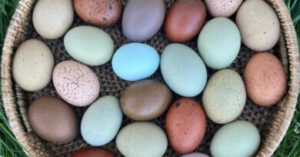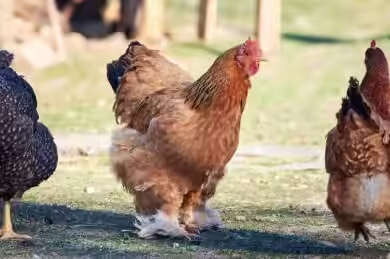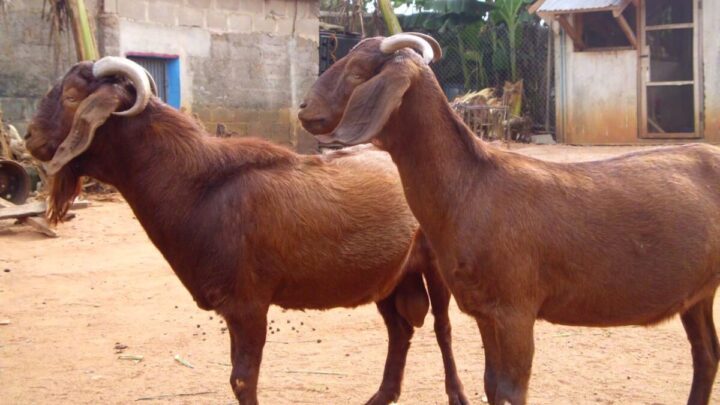Last updated on May 24, 2025
You got Easter Egger chicks, didn’t you? You’re probably watching them grow, getting bigger every day, and wondering with excitement: When do Easter Eggers start laying eggs? It’s the big question, right? You’re dreaming of those beautiful, colorful eggs filling your carton! Knowing exactly at what age do Easter Eggers start laying eggs can feel like a bit of a mystery sometimes.
Well, I’ve been there! Waiting for those first colorful eggs is part of the fun of raising backyard chickens. I’ve put together 7 must-know facts that will help you understand the timeline and spot the signs that your pullets are getting ready. We’ll cover the typical Easter Egger laying age, what can speed things up or slow things down, and how to get your coop ready. Let’s make sure you’re ready for that exciting day and know all about chicken egg production from your flock!
1. The Typical Timeline: At What Age Do Easter Eggers Start Laying Eggs?
Alright, let’s get right to the most common question! At what age do Easter Eggers start laying eggs? Generally speaking, you can expect your Easter Eggers to start laying eggs somewhere between 5 to 7 months old. This is roughly 20 to 28 weeks.
Now, keep in mind, this is just an average. Some eager beavers might pop out their first egg a little earlier, maybe around 4 and a half months. Others might take a bit longer, pushing closer to 8 months. Every chicken is an individual, just like us! Things like the specific strain of Easter Egger (since they’re a hybrid, their genetic makeup can vary slightly) and even the overall health of the parent flock they came from can play a small role in when they mature. This typical Easter Egger laying age is a good benchmark, though. It gives you a timeframe to watch for those exciting changes. Compared to some commercial layer breeds that can start as early as 16-18 weeks, Easter Eggers take a little more time to mature, but it’s totally worth the wait for those unique egg colors! Understanding the average chicken age to lay helps set realistic expectations.
2. Beyond Just Age: Key Factors Influencing When Laying Starts
While age is a big factor, it’s definitely not the only thing that determines when do Easter Eggers start laying. Several key factors play a huge role in your pullet development and when they’ll be ready to join the ranks of laying hens. If you’re asking yourself, “why isn’t my Easter Egger laying?” these factors are usually the reason! These are the main factors affecting egg laying:
- Light Cycles: Chickens need around 14-16 hours of light per day to trigger egg production. Shorter days in fall/winter can delay laying.
- Time of Year: Pullets maturing when days are short often wait until spring to start laying.
- Nutrition: They need a balanced chicken layer feed with enough protein and calcium as they approach laying age (18-20 weeks).
- Stress: Things like predators, overcrowding (aim for 3-4 sq ft per bird indoors), extreme weather, or illness can delay or stop laying.
- Overall Health: Healthy birds start laying sooner and more consistently.
What are some of these terms?
Just a quick note on a few terms you’ll see:
- A pullet is a young female chicken, typically under one year old, that hasn’t started laying eggs yet.
- The vent is the external opening for a chicken’s reproductive, urinary, and digestive tracts.
- The comb and wattles are the fleshy red parts on a chicken’s head and under their chin.
- Layer feed is chicken feed formulated specifically for laying hens, with higher protein and calcium.
- Supplemental lighting means adding artificial light to the coop to extend daylight hours, especially in winter.
3. Spotting the Signs: How to Tell Your Easter Egger is Ready to Lay
Okay, so you know the age range and what factors matter. But how do you know, day-to-day, that your specific pullet is getting close? How to tell your Easter Egger is ready to lay? There are some pretty clear physical and behavioral signs to watch for! These are the tell-tale signs of laying Easter Egger.
Physical Changes Give Clues
Keep an eye on these physical pullet laying signs:
- Comb and Wattles: They will typically become larger, redder, and feel warmer to the touch.
- Pelvic Bones: Gently feel the two small bones on either side of their vent. In a non-layer, they’re close (1-2 fingers wide). In a hen ready to lay, they widen significantly (3-4 fingers wide or more).
- Vent: It will become larger, more moist, and change from a tight, round shape to a more oblong one.
These are classic signs of laying hen, letting you know your hen ready to lay.
Watch Their Behavior
Their behavior changes too! Look for these behavioral clues:
- Submissive Squatting: They might crouch down low when you approach, sometimes spreading wings slightly.
- Nesting Box Interest: Increased jumping in and out of nesting boxes, rearranging bedding. This nesting box behavior is a key indicator.
- “Egg Song”: A new, loud, cackling sound, often before or after laying.
- Increased Appetite: Eating a bit more as their bodies prepare for production.
4. The Very First Eggs: Small, Sometimes Quirky, But Oh So Exciting!
That first egg is a moment to celebrate! But don’t be surprised if it’s not a perfect, full-sized egg. The chicken first egg is often smaller than what the hen will lay later on. These are often called “pullet eggs Easter Egger” or simply pullet eggs.
You might also notice some irregularities in shape, shell thickness, or even a bit of speckling that wasn’t expected. This is totally normal! Their reproductive system is just getting warmed up and figuring things out. The size and consistency of the eggs – meaning their uniform shape, shell quality, and overall appearance – will improve over the next week or two as they get into a routine.
And yes, the color you get with that first egg is the color that hen will continue to lay for her lifetime – whether it’s a beautiful sky blue egg, a lovely forest green egg, a unique olive color, or sometimes even pinkish or brownish tints depending on the specific genetics that make up your Easter Egger! Remember, the color of the egg is determined by the hen’s genetics, not whether there’s a rooster present. Get ready for those beautiful colorful eggs.
Keep in mind that the intensity of the color – how light or dark the blue, green, or olive shade appears – can sometimes vary slightly, perhaps being lighter or darker at different times of the year or during their laying cycle.
5. Do Easter Eggers Lay in Winter? Addressing Seasonal Production
This is a common question, especially if your pullets mature as the days get shorter. Do Easter Eggers lay in winter? Naturally, egg production tends to decrease or even stop entirely during the winter months. This is because of the reduced daylight hours; it’s a natural rest period for the hen’s reproductive system. This is part of their natural chicken egg production cycle.
However, if your pullets start laying late in the fall, they might continue to lay through their first winter. Also, you can encourage winter laying by providing supplemental lighting in the coop to ensure they get 14-16 hours of total light per day (combining natural daylight and artificial light).
A simple timer works great for this! Just be aware that forcing production year-round can potentially shorten a hen’s overall laying lifespan compared to allowing them a natural break. It’s a personal choice for your backyard chickens and impacts winter egg production. For more detailed tips on winter care for laying hens, check out resources like this guide from UMaine Cooperative Extension. You can also find information on managing winter egg production from K-State Research and Extension.
6. My Easter Egger Isn’t Laying Yet! Why the Wait?
If your Easter Eggers are past that typical 7-month mark and you’re still not seeing eggs, it’s understandable to feel a bit impatient! There are a few common reasons for delayed laying in Easter Eggers. If you’re asking “why isn’t my Easter Egger laying?” consider these potential issues:
Here’s a quick checklist for troubleshooting delayed laying:
- Verify Age: Are they truly past the 7-8 month mark? Sometimes our chicks are younger than we think!
- Check Lighting: Are they getting 14-16 hours of light per day? This is especially critical if they matured in the fall or winter.
- Evaluate Diet: Are they on a good quality chicken layer feed? Are they getting enough protein and calcium? Are they eating it consistently?
- Assess Stress Levels: Have there been any recent changes, predator scares, or signs of bullying in the flock? Is the coop overcrowded?
- Check for Physical Signs: Are they showing any of the physical signs of getting ready to lay (red comb/wattles, widening pelvic bones, changing vent)? If yes, they might just need a little more time.
- Observe Health: Do they seem healthy and active, or are there any signs of illness or parasites?
Knowing the typical chicken age to lay helps you gauge if there’s truly a delay, and these are key factors affecting egg laying. For more on troubleshooting laying issues, resources like Poultry Extension and Virginia Cooperative Extension offer helpful guides.
7. Getting Ready for the Big Day: Preparing Your Flock and Coop
You’ve watched for the signs, you know the timeline, now how do you prepare? Getting your flock and coop ready for egg production is simple but important.
Around 18-20 weeks, transition your pullets to a good quality chicken layer feed. This ensures they get the necessary nutrients, especially calcium. You should also provide a separate source of calcium, like oyster shell, in a small dish. They’ll take what they need. Why offer extra calcium even with layer feed? Because individual hens have different needs, and providing it separately ensures they get exactly what their body requires for strong shells without over-consuming it in their main feed. Make sure you have clean, comfortable nesting boxes available.
A good rule of thumb is one nesting box for every 4-5 hens, but more won’t hurt! Ensure they have constant access to fresh, clean water. Finally, continue to maintain a low-stress environment. Happy, comfortable hens are laying hens! Understanding these 7 must-know facts about when Easter Eggers start laying eggs truly helps backyard chicken keepers be prepared. For comprehensive guides on raising layer pullets and general chicken care, check out resources from university extensions like UMN Extension or UNH Cooperative Extension.
Conclusion: The Reward is Worth the Wait!
Waiting for those first colorful eggs from your Easter Eggers is part of the journey of raising backyard chickens. We’ve covered the typical Easter Egger laying age (around 5-7 months), the key factors affecting egg laying (light, diet, stress, health), how to spot the pullet laying signs (physical changes, behavior like the submissive squat and nesting box behavior), what to expect from that exciting chicken first egg (small, sometimes quirky pullet eggs Easter Egger), whether Do Easter Eggers lay in winter (naturally, less or not at all without supplemental light for winter egg production), common reasons for delays (why isn’t my Easter Egger laying?), and how to get everything ready (like switching to chicken layer feed).
Knowing these 7 must-know facts about when Easter Eggers start laying eggs helps manage expectations and ensures you’re providing the best possible care to encourage production. Soon, you’ll be collecting those beautiful blue eggs, green eggs, olive eggs, and other unique colorful eggs you’ve been waiting for. Trust me, the reward of those unique colors in your egg carton is absolutely worth the wait!
And hey, if you’re ever feeling unsure or just want to share your excitement (or frustrations!), don’t hesitate to reach out to other chicken keepers. Local poultry groups or online forums are fantastic resources for support and advice from folks who’ve been there.
What color egg are you most excited to find? Share your thoughts in the comments below!
Frequently Asked Questions About Easter Egger Laying
At what age do Easter Eggers lay their first egg?
Easter Eggers typically start laying eggs between 5 to 7 months old (roughly 20-28 weeks).
What are the signs an Easter Egger is about to lay?
Look for physical signs like a larger, redder comb and wattles, widening pelvic bones, and a larger, moist vent. Behavioral signs include submissive squatting, increased interest in nesting boxes, and the “egg song.”
Do Easter Eggers stop laying in the winter?
Naturally, egg production decreases or stops in winter due to shorter daylight hours. Supplemental lighting can encourage laying, but many hens take a natural rest break.
What do Easter Eggers eat before they start laying?
Before they start laying (around 18-20 weeks), they should be on a starter feed (high protein) followed by a grower feed. As they approach laying age, transition them to a chicken layer feed.
Why isn’t my Easter Egger laying eggs yet?
Common reasons include being too young, insufficient daylight hours, improper diet (not on layer feed or lacking nutrients), stress, or underlying health issues.
What color eggs do Easter Eggers lay?
Easter Eggers can lay eggs in shades of blue, green, olive, and sometimes pinkish or brown. Each individual hen will consistently lay one color.
What is a pullet egg?
A pullet egg is the first egg laid by a young hen (pullet). These eggs are typically smaller and may have irregularities in shape or shell quality initially.
How many eggs do Easter Eggers lay per week?
Easter Eggers typically lay about 3-4 eggs per week when they are in peak production.
Do Easter Eggers lay every day?
No, most chickens, including Easter Eggers, do not lay an egg every single day. A hen’s reproductive cycle takes slightly longer than 24 hours.
How long do Easter Eggers lay eggs?
Easter Eggers are most productive in their first 2-3 years of laying. Production typically decreases after that, though they may continue to lay fewer eggs for several more years.
What is the best time of year for Easter Eggers to start laying?
Pullets that reach maturity in the spring or early summer often start laying sooner because the daylight hours are naturally increasing.
Do Easter Eggers need a rooster to lay eggs?
No, hens do not need a rooster to lay eggs. They will lay eggs regardless. A rooster is only needed if you want fertilized eggs to hatch chicks.


